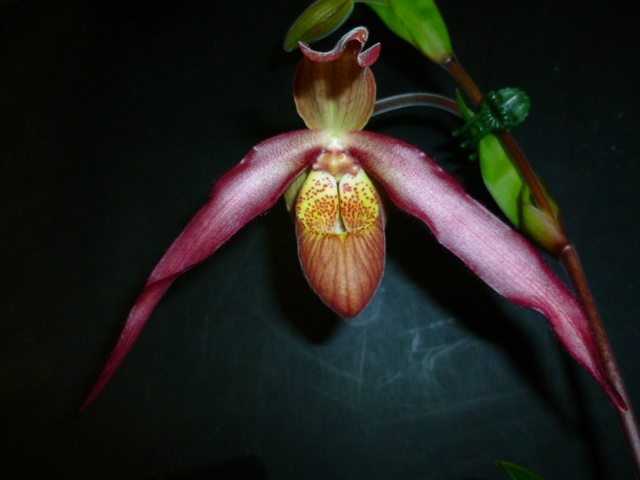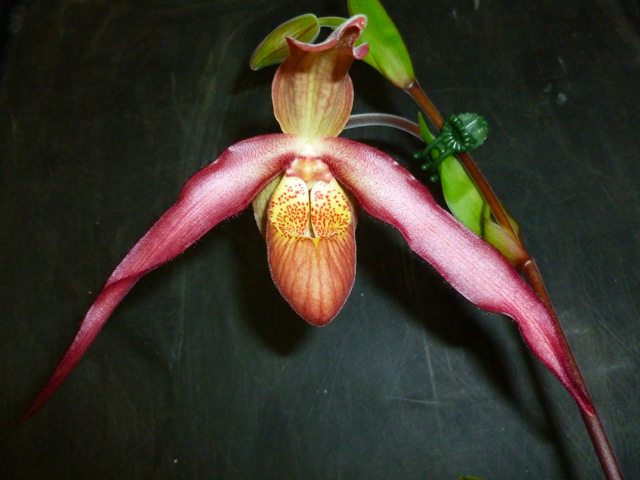mrhappyrotter
Grand Chupacabra
I've got lots of (maybe boring) backstory on this plant.
It was purchased around 2001 or 2002 from Breckinridge, which is now closed. At the time, it was a blooming sized, single growth plant. This clone is apparently extremely susceptible to rot, to the point that I have to inspect it almost daily to make sure it's in good shape. The rot always starts at the base of the oldest leaves, but progresses rapidly if I don't proactively remove them. So over the years, it's been a battle to keep it alive.
For most of the time I've had it, this guy/gal has only produced a single new growth at a time. I've tried growing it with wet feet -- it resents that very much. So, over the years I've learned to water it like a paph.
For most of its life, the plant survived with 2 growths, an old growth and the newest growth. By the time a new growth would start, the oldest growth would either start to rot or die off naturally. Several years ago, it had a growth spurt and by end of season, I had a 4 growth plant. I made a tough decision and divided it at that point, so I'd have two plants and possibly be able to experiment with growing conditions to see if I could appease it.
Starting last summer, the divisions began to produce spikes, but each and every time, they would blast. When the pictured plant started to spike, it got a major case of rot. So, I removed the affected leaves and placed it outside to isolate it from my other paphs and phrags. I fully expected it to blast the spike, but here we are ....


I like it. It's nowhere near the best Fliquet I've seen, but the flowers are large and I like the fact that the lip has an orangish hue that contrasts nicely with the petals. I know, the photos aren't so good. I'm not a photographer. It's still in the process of opening, but I think it'll get slightly better. And no, I did not sacrifice any goats or virgins in an attempt to please the orchid gods to let this thing finally bloom after over a decade of constant attention and effort.
It was purchased around 2001 or 2002 from Breckinridge, which is now closed. At the time, it was a blooming sized, single growth plant. This clone is apparently extremely susceptible to rot, to the point that I have to inspect it almost daily to make sure it's in good shape. The rot always starts at the base of the oldest leaves, but progresses rapidly if I don't proactively remove them. So over the years, it's been a battle to keep it alive.
For most of the time I've had it, this guy/gal has only produced a single new growth at a time. I've tried growing it with wet feet -- it resents that very much. So, over the years I've learned to water it like a paph.
For most of its life, the plant survived with 2 growths, an old growth and the newest growth. By the time a new growth would start, the oldest growth would either start to rot or die off naturally. Several years ago, it had a growth spurt and by end of season, I had a 4 growth plant. I made a tough decision and divided it at that point, so I'd have two plants and possibly be able to experiment with growing conditions to see if I could appease it.
Starting last summer, the divisions began to produce spikes, but each and every time, they would blast. When the pictured plant started to spike, it got a major case of rot. So, I removed the affected leaves and placed it outside to isolate it from my other paphs and phrags. I fully expected it to blast the spike, but here we are ....


I like it. It's nowhere near the best Fliquet I've seen, but the flowers are large and I like the fact that the lip has an orangish hue that contrasts nicely with the petals. I know, the photos aren't so good. I'm not a photographer. It's still in the process of opening, but I think it'll get slightly better. And no, I did not sacrifice any goats or virgins in an attempt to please the orchid gods to let this thing finally bloom after over a decade of constant attention and effort.



